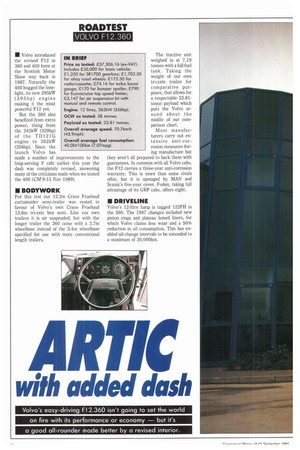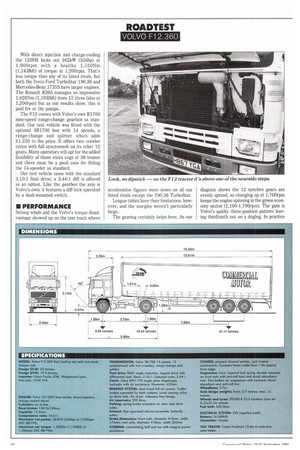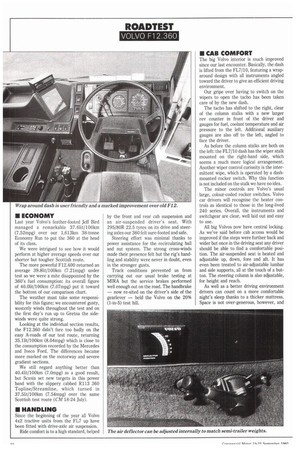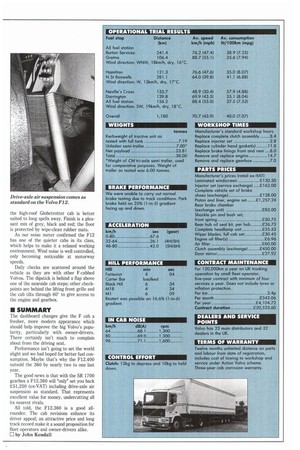ARC with added dash
Page 26

Page 28

Page 29

Page 30

Page 31

If you've noticed an error in this article please click here to report it so we can fix it.
Volvo's easy-driving F12.360 isn't going to set the world on fire with its performance or economy — but it's a good all-rounder made better by a revised interior.
• Volvo introduced the revised F12 in 360 and 400 form at the Scottish Motor Show way back in 1987. Naturally the 400 hogged the limelight, its new 295kW (395hp) engine making it the most powerful F12 yet.
But the 360 also benefited from extra power, rising from the 245kW (329hp) of the TD121G engine to 262kW (356hp). Since the launch Volvo has made a number of improvements to the long-serving F cab: earlier this year the dash was completely revised, answering many of the criticisms made when we tested the 400 (CM 9-15 Nov 1989).
Overall average speed: 70.7km/h (43.9mph).
• BODYWORK For this test our 12.2m Crane Fruehauf curtainsider semi-trailer was rested in favour of Volvo's own Crane Fruehauf 13.6m tri-axle box semi. Like our own trailers it is air suspended, but with the longer trailer the 360 came with a 3.7m wheelbase instead of the 3.4m wheelbase specified for use with more conventional length trailers.
The tractive unit weighed in at 7.19 tonnes with a full fuel tank. Taking the weight of our own tri-axle trailer for comparative purposes, that allows for a respectable 23.81tonne payload which puts the Volvo around about the middle of our comparison chart.
Most manufacturers carry out extensive anti-corrosion measures during manufacture but they aren't all prepared to back them with guarantees. In common with all Volvo cabs, the F12 carries a three-year anti-corrosion warranty. This is more than some rivals offer, but it is upstaged by MAN and Scania's five-year cover. Foden, taking full advantage of its GRP cabs, offers eight.
• DRIVELINE
Volvo's 12-litre lump is tagged 122F11 in the 360. The 1987 changes included new piston rings and plateau honed liners, for which Volvo claims less wear and a 50% reduction in oil consumption. This has enabled oil-change intervals to be extended to a maximum of 30,000km. With direct injection and charge-cooling the 122F11 kicks out 262kW (356hp) at 1,900rpm with a healthy 1,550Nm (1,1431bft) of torque at 1,20Orpm. That's less torque than any of its listed rivals, but both the Iveco Ford TurboStar 190.36 and Mercedes-Benz 1735S have larger engines. The Renault R365 manages an impressive 1,620Nm (1,193Ibft) from 12 litres (also at 1,200rpm) but as our results show, this is paid for at the pumps.
The F12 comes with Volvo's own R1700 nine-speed range-change gearbox as standard. Our test vehicle was fitted with the optional SR1700 box with 14 speeds, a range-change and splitter which adds £1,250 to the price. It offers two crawler ratios with full syncromesh on its other 12 gears. Many operators will opt for the added flexibility of those extra cogs at 38 tonnes and there must be a good case for fitting the 14-speeder as standard.
Our test vehicle came with the standard 3.10:1 final drive; a 3.44:1 diff is offered as an option. Like the gearbox the axle is Volvo's own: it features a diff-lock operated by a dash-mounted switch.
• PERFORMANCE
Strong winds and the Volvo's torque disadvantage showed up on the test track where acceleration figures were down on all our listed rivals except the 190.36 TurboStar.
League tables have their limitations, however, and the margins weren't particularly large.
The gearing certainly helps here. As our diagram shows the 12 synchro gears are evenly spread, so changing up at 1,700rpm keeps the engine spinning in the green economy sector (1,100-1,700rpm). The gate is Volvo's quirky three-position pattern leaving third/sixth out on a dogleg. In practice it's easy to adapt to, probably because of the similarity in positions to the top gears on a five-speed gate.
Like most synchro boxes, the change is not particularly quick and can be heavy. But throughout the test it never failed to de liver, and if the price of positive gear selection is a slower change, it's a price we're prepared to pay.
A blocking device prevents accidental selection of low range so there's no risk of unintended over-revving. We also liked the
...
switch to select high or low ....... 91...
range. Experiments showed that the best shift pattern in normal running was to pull away in 1L and skip to 3L, taking whole gears to 5L and then splitting the top two ratios.
All right-hand-drive big Volvos are fitted with accelerators controlled by compressed air. Volvo says this is because the fuel injection equipment is on the engine's nearside so a conventional rod linkage would be too complex. Lack of a direct linkage does make the throttle less progressive, but it can be mastered with practice. Our test vehicle was also fitted with an Econocruise top speed limiter which takes some of the clock watching out of motorway running.
As specified our F12 has a claimed rolling gradeability of 38% (1-in-2.6). We were unable to re-start on the 2096 (1-in-5) test hill for lack of traction.
• ECONOMY
Last year Volvo's feather-footed Jeff Bird managed a remarkable 37.61it/100km (7.52mpg) over our 1,613km 38-tonne Economy Run to put the 360 at the head of its class.
We were intrigued to see how it would perform at higher average speeds over our shorter but tougher Scottish route.
The more powerful F12.400 returned an average 39.81it/1001an (7.21mpg) under test so we were a mite disappointed by the 360's fuel consumption: its overall figure of 40.0k/1001mi (7.07mpg) put it toward the bottom of our comparison chart.
The weather must take some responsibility for this figure; we encountered gusty, westerly winds throughout the test and on the first day's run up to Gretna the sidewinds were quite strong.
Looking at the individual section results, the F12.360 didn't fare too badly on the easy A-roads of our test route, returning 35.11it/100km (8.04mpg) which is close to the consumption recorded by the Mercedes and Iveco Ford. The differences became more marked on the motorway and severe gradient sections.
We still regard anything better than 40.41it/100km (7.0mpg) as a good result, but Scania set new targets in this power band with the slippery cabbed R113 360 Topline/Streamline, which turned in 37.51it/100km (7.54mpg) over the same Scottish test route (CM 18-24 July).
• HANDLING
Since the beginning of the year all Volvo 4x2 tractive units from the FL7 up have been fitted with drive-axle air suspension. Ride comfort is to a high standard, helped by the front and rear cab suspension and an air-suspended driver's seat. With 295/80R 22.5 tyres on its drive and steering axles our 360 felt sure-footed and safe.
Steering effort was minimal thanks to power assistance for the recirculating ball and nut system. The strong cross-winds made their presence felt but the rig's handling and stability were never in doubt, even in the stronger gusts.
Track conditions prevented us from carrying out our usual brake testing at MIRA but the service brakes performed well enough out on the road. The handbrake — now re-sited on the driver's side of the gearlever — held the Volvo on the 20% (1-in-5) test hill.
• CAB COMFORT
The big Volvo interior is much improved since our last encounter. Basically, the dash is lifted from the FL7/10, featuring a wraparound design with all instruments angled toward the driver to give an efficient driving environment.
Our gripe over having to switch on the wipers to open the tacho has been taken care of by the new dash.
The tacho has shifted to the right, clear of the column stalks with a new larger rev counter in front of the driver and gauges for fuel, coolant temperature and air pressure to the left. Additional auxiliary gauges are also off to the left, angled to face the driver.
As before the column stalks are both on the left: the FL7/10 dash has the wiper stalk mounted on the right-hand side, which seems a much more logical arrangement. Another wiper control curiosity is the intermittent wipe, which is operated by a dashmounted rocker switch. Why this function is not included on the stalk we have no idea.
The minor controls are Volvo's usual large, colour-coded rocker switches. Volvo car drivers will recognise the heater controls as identical to those in the long-lived 240 series. Overall, the instruments and switchgear are clear, well laid out and easy to use.
All big Volvos now have central locking. As we've said before cab access would be improved if the steps were further back and wider but once in the driving seat any driver should be able to find a comfortable position. The air-suspended seat is heated and adjustable up, down, fore and aft. It has even been treated to air-adjustable lumbar and side supports, all at the touch of a button. The steering cohunn is also adjustable, for height and reach.
As well as a better driving environment drivers can count on a more comfortable night's sleep thanks to a thicker mattress. Space is not over-generous, however, and the high-roof Globetrotter cab is better suited to long spells away. Finish is a pleasant mix of grey, black and red; the floor is protected by wipe-clean rubber mats.
As our noise meter confirmed the F12 has one of the quieter cabs in its class, which helps to make it a relaxed working environment. Wind noise is well controlled, only becoming noticeable at motorway speeds.
Daily checks are scattered around the vehicle as they are with other F-cabbed Volvos. The dipstick is behind a flap above one of the nearside cab steps; other checkpoints are behind the lifting front grille and the cab tilts through 60° to give access to the engine and gearbox.
• SUMMARY
The dashboard changes give the F cab a fresher, more modern appearance which should help improve the big Volvo's popularity, particularly with owner-drivers. There certainly isn't much to complain about from the driving seat.
Performance isn't going to set the world alight and we had hoped for better fuel consumption. Maybe that's why the F12.400 outsold the 360 by nearly two to one last year.
The good news is that with the SR 1700 gearbox a F12.360 will "only" set you back £51,250 (ex-VAT) including drive-axle air suspension as standard. That represents excellent value for money, undercutting all its nearest rivals.
All told, the F12.360 is a good allrounder. The cab revisions enhance its driver appeal; an attractive price and long track record make it a sound proposition for fleet operators and owner-drivers alike.
El by John Kendall




























































































